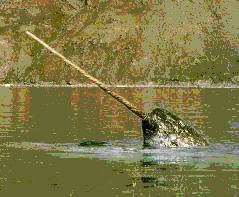
Credit: http://www.studentsonice.com/arctic2004/assets/images/narwhale.jpg
The narwhal (Monodon monoceros) is actually a "toothed whale". And only the males have these tusks. But unlike other whales, narwhals have no dorsal fin. What’s a dorsal fin you say? Its that big fin on the back of fishes, like the one on a shark’s back which you can see sticking out of water as it swims just below the surface. This whale inhabits ice covered Arctic seas, and only rarely wandering into temperate waters, and so the loss of the dorsal fin may have had something to do with it getting in the way when the whale was completely under ice. These chappies are heavy really, males weigh about 1.6 tons while females are on the lighter side, only 0.9 tonnes or so. But it’s the tusk which is the most striking feature of narwhales, and it can be upto 8 feet long ! that’s taller than most tall basketball players. But what good is such a long tooth you may ask? It has been a difficult question no doubt. Nature works in secret ways, and its takes time for us to come to come to see the light of how things may have come about. But before we see why its easier to see what. And what has been found is that the tooth is actually a sensor. (remember Ampullae of Lorenzini?). It helps the whales test the water quality. So this big antenna protruding in front of the narwhal is actually continuously telling the whale loads of stuff about the surrounding water, like water temperature, pressure, and salinity. This entire tooth is covered with a very delicate, thin membrane which in innervated by nearly 10 million nerve connections, which means it is extremely sensitive. It is a unique biological adaptation, one that is not yet completely understood. Why does a narwhal need such a fantastic sensor? Male narwhales ususually rub their tusks together and no doubt this must be a somewhat unique sensation. It may also be that the tooth serves the in the matter of social dominance among the males, as females do not seem to suffer any survival problems with the lack of this tusk.
In medieval times narwhal tusks have been sold to unsuspecting buyers who were convinced these were horns of unicorns, and had magical properties. The reality that these were whale’s teeth, had it become known would have certainly reduced their prices which was at least their weight in gold.
Wednesday, December 14, 2005
Narwhal Sensor
Posted by
-
at
6:57 AM
0
comments
![]()
Labels: ampullae of lorenzini, arctic, dorsal fin, fish, narwhal, narwhale, sperm whale, toothed whale, unicorn
Subscribe to:
Comments (Atom)
